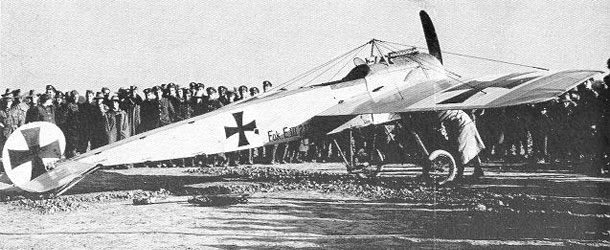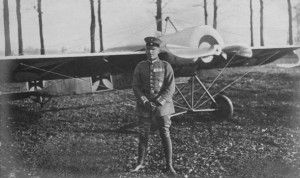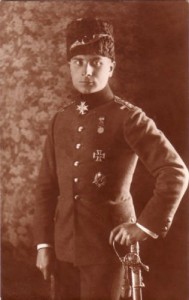The first WW1 Wings of Glory Airplane Packs will be released in the spring, at the same time as the Rules and Accessories Pack.
This new series of preview articles will present the four airplanes included in these Airplane Packs, starting with the German single-seat monoplane Fokker E.III, which was also used by the Austro-Hungary Empire and Turkey.
The Fokker E.III was the main variant of the Fokker “Eindecker” (German for "Monoplane"), the first aircraft armed with a synchronized, forward firing machine gun. The earliest planes of World War One were not able to fire through the propeller, the most effective place for a machine gun given the pilot’s line of sight and the plane’s forward direction. So, when the Fokker Eindecker came out, in mid-1915, it was very successful, starting the so-called “Fokker Scourge”, when the German Eindeckers bested all their adversaries and dominated the skies over the Western Front.
Even if the Germans were the first to take advantage of the forward firing machine guns, the initial idea to build such an aircraft came from the French aviator Roland Garros, who had the idea to reinforce or armor the spot of the blades where some bullets would hit. He equipped his Morane-Saulnier in this way and shocked the German pilots, briefly ruling the skies, until he was forced down behind German lines and captured before he could destroy his top-secret plane.
The aircraft was delivered to the Dutch engineer Anthony Fokker, who was asked to design a comparably equipped machine. After a deep study of Garros’ plane, he thought the airplane itself was good enough, but the idea of bullets blindly smacking into the propeller and hopefully not knocking it out nor bouncing back to kill the pilot didn’t convinced him. So he devised a way of connecting the propeller shaft to the machine gun’s firing mechanism, and interrupting the gun whenever the propeller blade was in front of the muzzle. The synchronizer gear used was probably based in a 1913’s patent of Swiss engineer Franz Schneider.
The first model with the synchronization gear was the E.I, presented in May 1915, which was essentially an armed version of the Fokker M.5K single-seat reconnaissance aircraft. The fuselage structure was fabric covered welded steel tubing and the engine was a 60 kW (80 hp) Oberursel U.0. In June 1915, the E.II was presented, using a 75 kW (100 hp) Oberursel U.I 9-cylinder rotary engine. The production of both types therefore depended on engine availability and the two variants were built in parallel. Many E.IIs were either completed as E.IIIs or upgraded to E.III standard when returned for repair.
The Fokker E.III was the definitive version of the Eindecker. This variant was fitted with larger, newly designed wings that had a slightly narrower-chord (1.80 meter, or 71 inch) wing than earlier versions. The engine was the same of the E.II, but the fuel tank was larger, increasing its endurance to about 2 ½ hours – an hour more than the former version. Most of these monoplanes were armed with a single 7.92 mm (.312 in) Spandau LMG 08 machine gun with 500 rounds of ammunition; however, after the failure of the twin-gun Fokker E.IV as a viable successor, some E.IIIs were fitted with twin guns.
By late 1915 the Germans had achieved air superiority, and the first regularly scoring German ace pilots - notably Max Immelmann and Oswald Boelcke - began their careers at this time. Boelcke's Feldflieger Abteilung 62 began operating the E.III towards the end of that year. The E.III was the first type to arrive in sufficient numbers to form small specialist fighter units, Kampfeinsitzer Kommandos (KEK) in early 1916. Previously, Eindeckers had been allocated singly to the front-line Feldflieger Abteilungen that carried out reconnaissance duties.
But the Allies by that time had new fighters to match the Fokker Eindecker - the British F.E.2b and the D.H.2, able to fire forward without gun synchronization, and the French Nieuport 11, a tractor biplane with a forward firing gun mounted high on the top wing above the arc of the propeller. With these new aircrafts, by the closing stages of the Battle of Verdun and in time for the start of the Battle of the Somme, the "Fokker Scourge" was over.
The Fokker E.III in Wings of Glory
The three versions of the Fokker E.III to be featured in the first Airplane Packs of WW1 Wings of Glory are planes flied by Max Immelmann, known as the first ace of WW1, Ludwig Hautzmayer, pilot of Austro-Hungary empire, and Hans Joachim Buddecke, a German ace who took part of a successful campaign in Turkey.
Max Immelmann was born in Dresden in September 1890, and after leaving school he joined the German army, in 1911, but left its commission one year later to study mechanical engineering in Dresden. On the outbreak of war, he returned to the service as a reserve officer candidate, being assigned to Eisenbahnregiment Nr. 1. When the war started he was recalled to the active service and transferred to the Luftstreitkräfte, the Flying Corps, taking and passing his examination in March 1915 and being promoted to Lieutenant the following month.
Immelmann started his experiences as an airman operating as a reconnaissance pilot near Lille in northern France. In April 1915, he was assigned to Feld Flieger Abteilung 62, and engaged in combat in several occasions while flying the L.V.G. but without success. On 3 June 1915, he was shot down by a French pilot but managed to land safely behind German lines and was decorated with the Iron Cross, Second Class for preserving his aircraft.
When two very early versions of the Fokker Eindeckers were delivered to the unit, he received the E.13/15 production Fokker E.I – the other, a prototype production, went to Oswald Boelcke. The first confirmed Immelmann’s victory during the war was gained with this Fokker E.1, on 1st August 1915. Immelmann quickly built an impressive score of air victories and became known as the “Eagle of Lille” (Der Adler von Lille). By the fall of 1915, he was one of the leading Germany’s aces, together with Oswald Boelcke, as the two pilots collected victories and chased each other in an ace race that last until June 1916. The two aces were the first ones to be awarded with the Pour le Mérite, Germany's highest military honor. Immelman received it on the day of his eighth win, and the medal became unofficially known as the "Blue Max" in the German Air Service, in his honor.
In the late afternoon of 18 June 1916, Immelmann led a flight of four Fokker E.III Eindeckers in search of a flight of eight F.E.2b reconnaissance aircraft of 25 Squadron Royal Flying Corps over Sallaumines, in northern France. Immelmann's flight intercepted them and after a long-running fight, he brought down one of the enemy aircraft, wounding both the pilot and observer. This was his 16th victory. Later that same evening, in the Fokker E.III 246/16, Immelmann encountered 25th Squadron again. Immediately, he got off a burst which hit the pilot of one of the pushers, killing him instantly and scoring his 17th and last victory.
Still fighting with the 25th Squadron that evening, Immelman was killed. According to British accounts, gunfire from an FE-2 piloted by Lt. G.R. McCubbin and gunned by Cpl. J. H. Waller hit Immelmann's Fokker and it dived to the ground. The German Air Service at the time claimed the loss was due to (friendly) anti-aircraft fire, and others, including Immelmann's brother, believed his aircraft's gun synchronization had malfunctioned with catastrophic results. And so as many events of World War One's aerial combat, the death of Max Immelmann is still a matter of debate.
Besides his high victory score for the early years of the WW1, Immelmann is also known as a great pioneer in fighter aviation as his name has become attached to common flying tactics. Immelmann turn refers to two different aircraft maneuvers. In World War I aerial combat, an Immelmann turn was a maneuver used after an attack on another aircraft to re-position the attacking aircraft to dive back down to re-attack, while in modern aerobatics, an Immelmann turn (also known as a roll-off-the-top, or simply an Immelmann) is an aerobatic maneuver that results in level flight in the opposite direction at a higher altitude.
Other Fokker E.III arriving in the Airplanes Packs was an aircraft piloted by Oberleutnant Ludwig Hautzmayer of the Kaiserliche und Koenigliche Luftfahrtruppen at Flik 19. The air force of the Austro-Hungarian Empire saw combat on both the Eastern Front and Italian Front during World War I.
Born in Fürstenfeld, Austria in April 1893, Hautzmayer served at the units Fliegerkompagnie (Flik) 19, 51J and 61J. He flied a Fokker E.III (or Fokker A.III, in the Austro-hungarian denomination) called Snow Bird in 1916, when he served at Flik 19, and scored two of his seven victories with this aircraft. Snow Bird was mostly employed in strafing maneuvers in support of the Austro-Hungarian troops along the Italian Front. His other victories were achieved flying a Hansa-Brandenburg C.I and the Albatros D.III.
Hautzmauyer died on 6 December 1936, in an accident at the Croydon Airport, in England. He was the captain of a KLM airliner that crashed shortly after taking off on a scheduled flight to Amsterdam, Netherlands. The airport was shrouded in fog with visibility fluctuating at around 50 m. The aircraft was destroyed and 15 of the 17 passengers and the crew on board died.
The E.III piloted by Hauptmann Hans-Joachim Buddecke was the aircraft used by the German pilot when he was sent to Gallipoli, in Turkey, to fight with Ottoman FA 6 (6 Bölük, Kuvva-i Havvaie) against the Royal Naval Air Service, from December 1915 to August 1916. There he performed a successful campaign, with four victories confirmed and seven unconfirmed. Credited with thirteen victories, Buddecke saw combat also in Bulgaria and on the Western Front and he was the third ace, after Max Immelmann and Oswald Boelcke, to earn the Pour le Mérite medal.
Born in Berlin, in August 1890, Buddecke entered in the Army very young, becoming a Leutnant in 1910. Three years later he left the army and moved to the USA, where he worked as mechanical in a car factory and saved earnings to buy his own aircraft, a Nieuport, learning to fly by himself. He was starting his own aircraft production when the war was declared and so he abandoned his plans and returned to Germany using a fake name and then joined the German Flying Service.
Sent to the Western Front in September 1914, he initially flew as an observer but soon he would become a single-seater fighter pilot with FFA 23. His previous experience on monoplanes convinved his friend Rudolph Berthold to propose that he should fly the first of the Fokker Eindecker aircraft delivered to the unit. The two friends, flying the Eindecker and a AEG G.II (Berthold), formed a small Kampfstaffel within the unit, intercepting British reconnaissance aircraft, and Buddecke scored his first three victories during this assignment.
On December 1915 he went to Turkey, at FA 6, and in late August 1916 was recalled to the Western Front as leader of the newly formed Royal Prussian Jagdstaffel 4. There he reached other three victories in September 1916. After that he went back to Turkey, joining the Ottoman FA5, and scored two victories in Smirne by March 1917. In early 1918, he was again in France with the Jasta 30, and following was assigned to Royal Prussia Jagdstaffel 18. He was killed in action on 10 March 1918, during an aerial combat over Lens, France.
Information sources: Acepilots.com, FirstWorldWar.com, The Aerodrome, WWI Aviation, Wikipedia.











